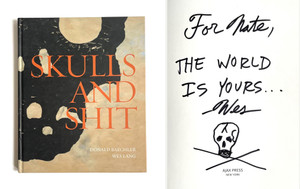
Lazar Khidekel
Original Suprematist Composition, ca. 1920
Color watercolor on paper
Signed, inscribed and stamped
Unique
Frame included
"They will understand us in 100 years"
Lazar Khidekel, ca. 1920
Suprematist, Avant-Garde Russian artist and student of Malevich
Lazar Khidekel Markovitch:
Художник: Хидекель Лазарь Маркович
Watercolor on paper
(Бумага; акварель)
Hand signed with monogram bottom left, inscribed with title on the back and stamped
(Монограмма внизу слева, название на обороте)
Elegantly floated and framed in a handmade wood frame with UV plexiglass, with a die-cut window in the back to reveal the handwriting and stamp
Measurements:
Framed
15.5 inches by 18.25 inches by 1 inch
Artwork
8.25 inches vertical by 10.25 inches horizontal
Provenance:
Boisgirard & Associés: Wednesday, March 26, 2008 [Lot 00060]
Ecole de Paris : Pologne, Russie, Europe Centrale
LAZAR KHIDEKEL BIOGRAPHY
Lazar Khidekel (1904 in Vitebsk – 1986 in Saint Petersburg, formerly Leningrad), artist and architect, is one of the most important representatives of the Russian avant-garde in the 1920s.
Lazar Khidekel classified himself as an “artist-architect,” later adding the moniker “fantasist” in reference to one of the central features of his art and architecture: “vision of Suprematist structures floating in space,” which first emerged as space stations of earthlings in his Vitebsk UNOVIS (Affirmers of New Art) works in 1920 – 1921, and the futuristic cities he conceived in the mid-1920s.
Khidekel was initially trained and nurtured as an artist by the best painters of the time. His first teacher, Marc Chagall, counted him as among the most talented painters in his studio. On encountering his former student during his 1973 visit to Russia, Chagall immediately recognized Khidekel and expressed astonishment that one of his best students had become an architect rather than a painter. With Chagall’s encouragement, fifteen-year-old Khidekel – who attended art school for less than a year – was exhibited alongside luminaries of modern art, including Chagall, Vassily Kandinsky, and Kazimir Malevich. Khidekel went on to become, in the words of his friend and fellow member of UNOVIS Ilya Chashnik, the only truly “revolutionary Suprematist.”
Lazar Khidekel's career resembles a paradigm for an artist's existence in the environment of the Russian avant-garde: like Marc Chagall, Lazar Khidekel was also born into an Orthodox Jewish working-class family in Vitebsk. Due to the outbreak of the revolution in 1917, Khidekel could not complete secondary school. In 1918, at 14 years of age, he applied to the local art school with paintings and drawings – and was accepted. He was taught by Marc Chagall – the founder of the school – as well as by El Lissitzky and Kazimir Malevich. By 1920, at the young ago of only 16, Khidekel already writes his influential manifesto "AERO". In this piece of writing, with a passionate tone throughout, the young artist advocates a green city, in which the modern human being is to live in harmony with nature. This topic would pre-occupy Khidekel for his entire life. After completing advanced studies in architecture at the end of the 1920s, he would go on to become one of the most renowned architects in Russia, and would also make a name for himself as an influential professor of architecture.
The present work, was completed around the time Khidekel wrote his famous manifesto AERO, and was studying alongside Chagall and Kandinsky.
A personal exhibition of Lazar Khidekel's work, the first in the history of Belarus, opened at the National Art Museum of the Republic of Belarus on the day of the 100th anniversary of UNOVIS, February 14, 2020.
Among the guests at the opening ceremony were participants of the international scientific and practical conference dedicated to 100 years of UNOVIS, which opened in Vitebsk on February 12 and closed in Minsk on February 14. The opening was attended by the heirs of the legendary art group creators: Lazar Khidekel's family - the renowned architect and designer Mark Khidekel, with his wife Regina Khidekel, and their son Roman Khidekel, an urban architect. Also present were the grand-niece of Kazimir Malevich, Ivona Malevich, and the great-granddaughter of El Lissitzky, Valeria Lissitzky.
About 100 original works and UNOVIS documents from the personal archive and collection of the Khidekel family were brought to Minsk from New York for the exhibition. It included early Suprematist compositions, projects of the futuristic cities such as Aero-cities and Garden-cities, space stations, as well as the legendary first architectural environmental manifesto AERO.
The exhibition was complemented by animations created by Roman Khidekel - fantasies on the space theme based on his famous grandfather's work.
For those interested in learning more about Khidekel, below is the publisher's blurb on a 2014 monograph of his work, published by the prestigious art publisher Prestel:
The first book dedicated solely to this important member of the Russian avant-garde, this volume profiles Lazar Khidekel, a brilliant artist and architect whose career proves a key link in the story of abstraction. For decades the work of Lazar Khidekel has been undeservedly overlooked by galleries and museums—primarily because the Russian avant-garde movement was interrupted midstream and forced underground by the Soviet state. This elegantly designed book provides the perfect introduction to Khidekel’s decades-long career and coincides with a recently renewed fascination with Suprematism and the development of 20th-century abstraction. A student of Chagall and Malevich, Khidekel was an artistic prodigy whose fascination with architecture led to his part in the founding of UNOVIS, or "Affirmers of the New Art." He later became a significant figure in the Suprematist movement, a distinctly Russian form of abstraction. The volume features the best examples from each phase of Khidekel’s career, from his pre-Suprematist work and early architectural and eco-futuristic projects to his post-Suprematist paintings, works on paper, and architectural projects.











